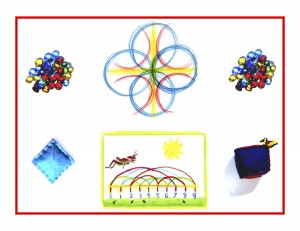Day 155
For one year, 365 days, this blog will address the Common Core Standards from the perspective of creating an alternate, ambient learning environment for math. Ambient is defined as “existing or present on all sides, an all-encompassing atmosphere.” And ambient music is defined as: “Quiet and relaxing with melodies that repeat many times.
Why ambient? A math teaching style that’s whole and all encompassing, with themes that repeat many times through the years, is most likely to be effective and successful. Today’s post will continue reviewing the Common Core ELA standards, which are listed in blue and are followed by their ambient counterparts.
English Language Arts Standards > Speaking & Listening > Grade 2
Comprehension and Collaboration:
CCSS.ELA-LITERACY.SL.2.1
Participate in collaborative conversations with diverse partners about grade 2 topics and texts with peers and adults in small and larger groups.
“Collaborative conversations, peers and adults in small and larger groups.” Is this not more likely to be found as a college level lesson plan, a teacher development seminar activity, or at a human resources staff meeting? This sort of group activity is much more adult in nature, not suited to typical 8 year olds. Focusing on grade 2 topics and texts more often than not leads to the dumbing down of content in order to inappropriately allow independent learning at a too-young age. Provided the necessary adult support, second graders can successfully navigate classic, quality literature.
CCSS.ELA-LITERACY.SL.2.1A
Follow agreed-upon rules for discussions (e.g., gaining the floor in respectful ways, listening to others with care, speaking one at a time about the topics and texts under discussion).
Give and take, reasoned discussions should not be expected of this age group. If children are told (telling is preferable to reading) a classic story with excellent, inherently moral content, it will resonate deeply, to be drawn upon lifelong. The story will rest in a deep well of understanding so the next day, drawing upon extensive powers of memory and retention, it can be retold by the children. If the structure is set up at the beginning as one of attentive listening to the storyteller (the teacher on day 1 and children on day 2) this will be ingrained, with no need for reminders or reinforcement. The subject matter, if sufficiently compelling, is the best disciplinarian and will always result in excellent attention.
CCSS.ELA-LITERACY.SL.2.1B
Build on others’ talk in conversations by linking their comments to the remarks of others.
Conversation per se is not yet possible. Yes, second graders will relate in their talk and play, but in childish, playful ways. They are not ready for this adult, reasoned model. The story is the life lesson they want and need, without directly preaching or teaching anything. It can provide an integrated, connected whole, holding the storytellers in a cohesive group, unified by the strong will to be faithful to the story. This again is sufficient discipline, with no need for reminders or reinforcement.
CCSS.ELA-LITERACY.SL.2.1C
Ask for clarification and further explanation as needed about the topics and texts under discussion.
Discussion. From the classical Latin, discussus, “a shaking” or Old French, discutere, “to strike asunder, break up.” Originally “examination, investigation, judicial trial.” Not yet! Surely, the ability to reason (at age 11 or 12) must be present for this to happen. If the material (or story) is presented as an integral whole there is no need for clarification or further explanation. Yes, childish curiosity is always there, from the beginning, but it’s just not analytical yet.
CCSS.ELA-LITERACY.SL.2.2
Recount or describe key ideas or details from a text read aloud or information presented orally or through other media.
This happens naturally and beautifully, everyday, as each story is retold by the children. Every detail is faithfully recounted from the story that has been presented orally (told) by the teacher. No other media is used because the human connection is so essential for true, effective teaching and learning.
CCSS.ELA-LITERACY.SL.2.3
Ask and answer questions about what a speaker says in order to clarify comprehension, gather additional information or deepen understanding of a topic or issue.
Since understanding is occurring at such a deep level, there is essentially no questioning of it. Questioning implies reasoning, which is not yet fully present. Do you remember Virginia, who famously asked if Santa Claus was real? It just so happens that Virginia was 8 years old at the time! Please read her letter and its well-known reply, with this is mind: your 8 year old is not ready to take on the cares of the world, nor should s/he be expected to. See Virginia’s letter and the editor’s reply below.
Knowledge ensues in an environment dedicated to imaginative, creative knowing, where student and teacher alike surrender to the ensuing of knowledge as a worthy goal. Tune in tomorrow to continue with the Common Core ELA standards and their ambient counterparts.
|












